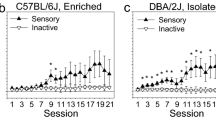Abstract
C57BL/6J and DBA/2J mouse strains have been characterized as morphine preferrers and avoiders, respectively (Horowitz et al. 1977). Previously, sweetened morphine solutions were presented with a water alternative, primarily with male subjects. Because sweetness may affect the endogenous opioid system and rodents have shown strain and sex differences in taste preferences, this study looked for strain- and gender-related taste preferences that might have affected opiate consumption. Preference for sweetened and unsweetened morphine and etonitazene was compared across gender and strain. In all choice tests, the control was a similar tasting quinine sulphate solution. Under these conditions, C57BL/6J mice continued to show strong preference for morphine. However, DBA/2J mice drank approximately equal amounts of morphine and quinine solutions, rather than avoiding morphine as when water was the alternative. Both strains appeared surprisingly indifferent to the synthetic opioid etonitazene, compared because it is potent at concentrations having barely perceptible bitterness. This raises the possibility of unexpected differences in post-ingestional effects between morphine and etonitazene. Contrary to reports of gender differences in sweet preference in rats, none were found in either strain of mouse. Neither were there any significant sex differences in opiate preference in either strain. C57 mice preferred sweetness more than did DBA mice.
Similar content being viewed by others
References
Alexander BK, Beyerstein BL, Hadaway PF, Coambs RB (1981) Effect of early and later colony housing or oral ingestion of morphine in rats. Pharmacol Biochem Behav 15:571–576
Baran A, Shuster L, Eleftheriou BE, Bailey DW (1975) Opiate receptors in mice: Genetic differences. Life Sci 17(4):633–640
Castellano C, Llovera BE, Oliverio A (1975) Morphine-induced running and analgesia in two strains of mice following septal lesions or modification of brain amines. Naunyn-Schmiedeberg's Arch Pharmacol 288:355–370
Chernov HI, Ambrose FG, Plummer AJ (1968) Pattern of consumption of etonitazene solutions by naive rats. Arch Int Pharmacodyn 175(2):309–318
Cooper SJ (1983) Effects of opiate agonists and antagonists on fluid intake and saccharin choice in the rat. Neuropharmacology 22(3A):323–328
Dykstra LA, Wharton W, McMillan DE (1977) Antagonism of etonitazene's effects in rats and pigeons. Pharmacol Biochem Behav 6:215–219
Eriksson K, Kiianmaa K (1971) Genetic analysis of susceptibility to morphine addiction in inbred mice. Ann Med Exp Fenn 49:73–78
Hadaway PF, Alexander BK, Coambs RB, Beyerstein BL (1979) The effect of housing and gender on preference for morphine-sucrose solution in rats. Psychopharmacology 66:87–91
Horowitz G (1976) Morphine self administration by inbred mice: A preliminary report. Behav Genet 6:109–110
Horowitz GP, Whitney G, Smith JC, Stephan FK (1977) Morphine ingestion: Genetic control in mice. Psychopharmacology 52:119–122
Howell DC (1982) Statistical methods for psychology. Duxbury Press, Boston
Klein TW, DeFries JC (1970) Similar polymorphism of taste sensitivitiy to PTC in mice and men. Nature 225:555–557
Lieblich I, Cohen E, Ganchrow JR, Blass EM, Bermann F (1983) Morphine tolerance in genetically selected rats induced by chronically elevated saccharine intake. Science 221:871–872
McMillan DE, Leander JD, Wilson TW, Wallace SC, Fix T, Redding S, Turk RT (1976) Oral ingestion of narcotic analgesics by rats. J Pharmacol Exp Ther 196(2):269–279
Meisch RA, Stark LJ (1977) Establishment of etonitazene as a reinforcer for rats by use of schedule-induced drinking. Pharmacol Biochem Behav 7:195–203
Nichols JR, Hsiao S (1967) Addiction liability of albino rats: Breeding for quantitative differences in morphine drinking. Science 157:561–563
Oliverio A, Castellano C, Eleftheriou BE (1975) Morphine sensitivity and tolerance: A genetic investigation in the mouse. Psychopharmacologia 42:219–224
Rosow CE, Miller JM, Pelikan EW, Cochin J (1980) Opiates and thermal regulation in mice. 1. Agonists. J Pharmacol Exp Ther 213(2):273–283
Synder SH, Childers SR (1979) Opiate receptors and opioid peptides. Annu Rev Neurosci 2:35–64
Valenstein ES, Kakolewski JW, Cox VC (1967) Sex differences in taste preference for glucose and saccharin solutions. Science 156:942–943
Whitney G, Horowitz GP (1978) Morphine preference of alcohol-avoiding and alcohol-preferring C57BL mice. Behav Genet 8(2):177–182
Zellner DA, Berridge KC, Grill HJ, Ternes JW (1985) Rats learn to like the taste of morphine. Behav Neurosci 99(2):290–300
Author information
Authors and Affiliations
Rights and permissions
About this article
Cite this article
Forgie, M.L., Beyerstein, B.L. & Alexander, B.K. Contributions of taste factors and gender to opioid preference in C57BL and DBA mice. Psychopharmacology 95, 237–244 (1988). https://doi.org/10.1007/BF00174516
Received:
Revised:
Issue Date:
DOI: https://doi.org/10.1007/BF00174516




